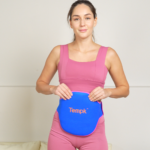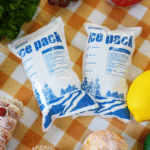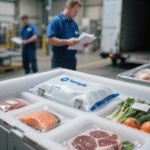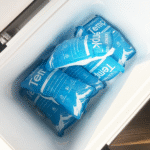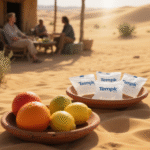Proper vaccine storage and cold chain practices are the backbone of immunization programs. Without consistent temperature control, vaccines lose potency, wasting money and putting public health at risk. This comprehensive guide answers your questions about vaccine storage and cold chain management in 2025, from temperature ranges and equipment choices to monitoring, transport and emerging innovations. It reflects the latest guidelines and market trends and uses plain language to help you protect every dose.

What is a vaccine cold chain and why is it essential? — understand how uninterrupted temperature control preserves vaccine efficacy.
Which temperatures are safe for vaccines? — learn the ranges for refrigerated, frozen and ultra cold vaccines and why deviations matter.
How do you choose storage equipment? — compare refrigerators, freezers and ultra cold units and see why dorm style fridges are a bad idea.
How should you monitor and record temperatures? — discover the role of digital data loggers (DDL), standard operating procedures and staff training.
¿Qué hay de nuevo en 2025? — explore innovations like blockchain, sensores de iot, solar powered units and portable cryogenic freezers that are transforming vaccine cold chain logistics.
What Is the Vaccine Cold Chain and Why Does It Matter?
The vaccine cold chain is the network of refrigerators, congeladores, insulated containers and monitoring devices that keep vaccines within safe temperature limits from manufacture to administration. Maintaining this chain preserves potency; vaccines that are too warm can lose up to 20 % of their effectiveness in just an hour, while freezing aluminium containing vaccines causes clumping and irreversible damage. Health care professionals must manage inventory accurately, use reliable equipment and employ trained staff to ensure every dose remains effective. Poor cold chain management leads to waste—studies estimate as many as 35 % of vaccines are compromised by temperature mishandling—and risks outbreaks of vaccine preventable diseases.
Maintaining Potency: Recommended Temperature Ranges
Vaccines are biological products that lose potency outside their prescribed ranges. Different categories require different conditions:
| Vaccine category | Rango de temperatura | Example vaccines | Significado |
| Refrigerado | 2 °C – 8 °C (36 °F – 46 °F) | Influenza, DTaP, HPV, MMR and most routine vaccines | The most common range; maintaining around 5 °C minimizes fluctuations. |
| Congelado | –50 °C – –15 °C (–58 °F – 5 °F) | Varicella, mpox (Jynneos), some COVID 19 formulations | Required for live attenuated vaccines; exposure to warmer temperatures can compromise viral components. |
| ultra frio | –90 °C – –60 °C (–130 °F – –76 °F) | mRNA vaccines like Pfizer–BioNTech Comirnaty | Necessary for long term storage; some vials may be thawed and kept at 2 °C–8 °C for up to 10 semanas. |
These ranges must be respected at all times. Overheating degrades proteins and lipids, while freezing forms ice crystals that damage vaccine structure. Even a brief excursion above 8 °C may reduce potency by 20 %. When storing vaccines, keep them in their original boxes to protect from light and arrange by expiration date for “first expiring, first out” rotation.
Selecting the Right Vaccine Storage Equipment
Choosing appropriate storage units is critical. Purpose built, pharmaceutical grade refrigerators and freezers provide the most consistent temperatures. These units feature electronic thermostats, alarms and interior fans and are designed to maintain uniform temperatures even during frequent door openings. When pharmaceutical units are unavailable, standalone household refrigerators or freezers can be used, pero combination refrigerator/freezers are not recommended, and dorm style units with a single exterior door should never be used because they pose a significant risk of freezing vaccines. Each storage unit should have enough capacity to accommodate peak inventory without overcrowding; vaccines should be stored in the middle of shelves, away from walls and the door where temperature fluctuations are greatest. Avoid storing vaccines in vegetable bins or alongside staff lunches.
Practical Tips for Organising Vaccine Storage
Set thermostats at mid range: Adjust refrigerators to approximately 5 °C and freezers to around –25°C to minimize fluctuations.
Keep air circulating: Avoid overcrowding and place water bottles on shelves to help stabilise temperatures.
Etiqueta claramente: Designate shelves for refrigerated and frozen vaccines; do not store diluents or food in vaccine units.
Rotar material: Store vaccines in original packaging, organise by expiry date and remove expired doses promptly.
Use backup equipment: Maintain a back up refrigerator or freezer and ensure power supplies have surge protection or an uninterruptible power supply.
Caso del mundo real: En 2024, a clinic in New York avoided wasting more than $20 000 worth of vaccines when a freezer failed. Staff executed their emergency plan to transfer inventory to a calibrated backup unit that maintained 2 °C-8 °C. This example underscores the value of preparedness and redundant storage.
Monitoring and Digital Data Loggers
Continuous temperature monitoring is the heart of vaccine cold chain management. The CDC recommends recording minimum and maximum temperatures at least twice daily and using digital data loggers (DDL) to track temperatures continuously. Every storage unit should be equipped with a DDL that records temperatures at least every 30 minutos, has a buffered probe, out of range alarm, low battery indicator, display of current and min/max temperatures and an uncertainty of ±0.5 °C. Data should be downloaded and reviewed at least every two weeks or whenever an excursion occurs. Facilities must retain records for at least three years.
Why Digital Data Loggers Matter
Vaccines are fragile, and even small temperature deviations can render them ineffective. DDLs provide continuous monitoring that manual checks cannot match. Features to look for include:
High precision and calibration: Devices should offer ±0.1 °C accuracy and be calibrated at key temperatures such as 2 °C y 8 °C.
Buffered probes: Glycol filled probes mimic the thermal response of vaccines, preventing false alarms caused by brief door openings.
Alertas en tiempo real: Visual and audible alarms alert staff as soon as temperatures deviate.
Cloud connectivity: Remote access and cloud storage allow staff to review data, receive alerts and generate audit reports from anywhere.
Hot swappable calibration: Some devices, como el 2025 EL USB VACX, offer on site calibration without downtime.
| DDL feature | Por que importa | Beneficio |
| Buffered probe | Measures liquid temperature rather than air, reflecting true vaccine temperature | Avoids false alarms when doors open; prevents unnecessary transfers |
| Out of range alarm | Alerts staff immediately when temperatures deviate | Enables rapid corrective action to save vaccines |
| Programmable logging interval | Allows recording at least every 30 minutos | Provides detailed temperature history for audits |
| Glycol simulation | Simulates vaccine thermal response to minimize false alarms | Improves accuracy in real world conditions |
| Cloud integration | Enables remote access, graphing and reporting | Simplifies audits and supports regulatory compliance |
Developing Standard Operating Procedures and Training
Monitoring alone is insufficient without clear procedures and trained personnel. Each facility should develop Standard Operating Procedures (Sops) covering routine storage and handling, monitoreo de temperatura, emergency responses and documentation. SOPs must be reviewed annually by a designated vaccine coordinator and updated whenever guidelines change. Staff should record min/max temperatures at the start of each workday and, if a device does not display min/max readings, check temperatures at least twice daily. Training is critical: all staff handling vaccines should receive orientation and annual refresher courses. Scenario based emergency drills prepare teams to respond to power outages, equipment failures or natural disasters.
Transport and Distribution: Protecting Vaccines On the Move
The cold chain extends beyond storage rooms. Vaccines must remain within their temperature ranges during transport from manufacturers to clinics. Logistics providers use contenedores aislados, refrigerants and data loggers to maintain cold chain integrity. Según una investigación de mercado, el mundial vaccine cold chain logistics market fue valorado en Dólar estadounidense 3.5 mil millones en 2024 and is predicted to reach Dólar estadounidense 5.9 mil millones por 2034, creciendo en un 5.3 % Tocón. Demand is driven by mRNA vaccines, advances in packaging technologies and growing awareness of health & wellness.
Choosing Packaging and Refrigerants
Different temperature ranges require different packaging methods. Dry ice provides temperatures around –78 °C and is suited for frozen or ultra cold shipments; gel packs and phase change materials maintain 2 °C–8 °C for refrigerated vaccines; liquid nitrogen enables cryogenic conditions below –150 °C for specialized cell therapies. The InsightAce report notes that packaging methods in the cold chain logistics market include hielo seco, liquid nitrogen and gel packs. Use validated containers and pack out designs that match the required temperature range, and consider shipping durations and external conditions. Always include a calibrated DDL inside the shipment and choose shipping routes that minimize transit times.
IoT Sensors and AI Driven Logistics
Modern vaccine logistics increasingly rely on connected sensors and analytics. Sensores inteligentes habilitados para IoT collect and share data on temperature, humedad y ubicación en tiempo real. When sensors detect unsafe temperature levels, they automatically alert users through text, email or mobile apps. Many devices also provide GPS tracking, allowing visibility across the supply chain and enabling rapid intervention if deviations occur. Coupling IoT sensors with inteligencia artificial improves route planning; AI algorithms use real time traffic and weather data to optimize routes, reducing transit time and minimizing the risk of temperature excursions. Predictive analytics identify patterns and trigger alerts before excursions happen. These technologies strengthen supply chain resilience and help meet regulatory requirements.
Innovations Shaping the 2025 Cadena de frío de vacuna
Beyond basic monitoring and transport, 2025 brings transformative technologies that enhance transparency, sostenibilidad y eficiencia:
Blockchain para una trazabilidad de extremo a extremo: Distributed ledgers record every transaction in the supply chain, creating a tamper proof log of temperature, location and hand off events. This transparency eliminates data manipulation and ensures regulatory compliance across stakeholders.
Almacenamiento en frío con energía solar: Off grid solar units provide reliable refrigeration in areas with unstable electricity. En 2024, commercial electricity cost an average of 13.10 centavos por kilovatio hora, whereas solar rates ranged from 3.2 a 15.5 centavos por kWh. Solar cold storage reduces energy costs and extends cold chain coverage to rural areas.
Sensores inteligentes habilitados para IoT: Wireless sensors offer real time temperature and location data, send alerts upon excursions and reduce operational risks. Combined with GPS, they allow complete visibility from origin to destination.
Optimización de rutas impulsada por IA: Artificial intelligence analyses traffic and weather patterns to select routes that maintain temperature stability. Predictive analytics identify potential excursions before they happen.
Congeladores criogénicos portátiles: New compact freezers maintain temperatures as low as –80 °C to –150 °C, enabling the safe transport of cell and gene therapies and ultra cold vaccines. Integrated real time tracking and alerts ensure compliance.
Embalaje sostenible: Companies are adopting recyclable insulated containers, biodegradable thermal wraps and reusable cold packs to reduce environmental impact. Sustainable solutions protect vaccines while aligning with corporate ESG commitments.
2025 Últimos desarrollos y tendencias
The cold chain industry is experiencing rapid growth and heightened regulatory scrutiny. Key developments include:
Accelerating market expansion: The global cold chain market is expected to grow from Dólar estadounidense 418.81 mil millones en 2025 a Dólar estadounidense 1,416.67 mil millones por 2034, representando un 14.5 % tasa de crecimiento anual compuesta. North America holds about 36 % of revenue and continues to invest in energy efficient technologies.
Rising demand for mRNA and biologic vaccines: The ongoing rollout of mRNA boosters and cell therapies necessitates ultra cold storage and robust monitoring, driving investment in cryogenic equipment.
Stricter compliance requirements: Regulatory bodies such as the CDC, WHO and EU GDP mandate continuous temperature monitoring, detailed record keeping and regular calibration. Facilities must demonstrate data integrity and readiness for audits.
Emergence of connected cold chains: Integration of IoT sensors, AI and blockchain fosters end to end visibility, enabling proactive intervention and improving patient safety.
Enfoque de sostenibilidad: Governments and companies are prioritizing renewable energy and recyclable materials to reduce the environmental footprint of cold chain operations.
Ideas del mercado: Growth and Investment Drivers
The cold chain sector supports both food and pharmaceutical industries, but vaccines represent a particularly high stakes segment. Según la investigación de precedencia, el global cold chain market is projected to grow at 14.5 % Tocón de 2025 a 2034. Mientras tanto, the dedicated vaccine cold chain logistics market—covering storage, packaging and transportation—will expand from Dólar estadounidense 3.5 mil millones en 2024 a Dólar estadounidense 5.9 mil millones por 2034. Factors driving growth include:
Surging vaccine production: Demand for mRNA boosters, varicella and other live vaccines necessitates more cold chain capacity.
Innovaciones tecnológicas: sensores de iot, blockchain and AI improve efficiency and reduce waste.
Expanding healthcare access: Rural immunisation programs and global disease eradication initiatives require reliable cold storage in remote areas, spurring investment in solar powered and portable solutions.
Cumplimiento regulatorio: Stricter guidelines for temperature monitoring, documentation and security compel facilities to upgrade equipment and systems.
Preguntas frecuentes
Q1: How long can mRNA vaccines be stored at refrigerator temperatures?
Después de descongelar, some mRNA vaccines such as the Pfizer–BioNTech Comirnaty may be kept at 2 °C-8 °C a hasta 10 semanas. Always check the manufacturer’s guidelines and monitor temperatures continuously.
Q2: What should I do if a vaccine is exposed to temperatures above 8 °C?
Any temperature excursion may degrade potency. Immediately quarantine the affected vaccines, label them “do not use,” and contact the manufacturer or immunisation program for guidance. Studies show that even a one hour exposure above 8 °C may reduce vaccine effectiveness by arriba a 20 %.
Q3: Can I store vaccines in a household refrigerator?
Household refrigerators may be used if pharmaceutical grade units are unavailable, pero combination units and dorm style fridges are not acceptable. Vaccines should be stored in the middle of shelves away from walls and the door.
Q4: How often should I record temperatures?
The CDC recommends checking and documenting minimum and maximum temperatures at least twice daily and downloading data from digital loggers every two weeks or after any excursion. If your logger displays min/max readings, record them at the start of each workday.
Q5: What should an emergency cold chain plan include?
A robust plan should cover backup power sources, alternative storage locations, transport containers and emergency contact information. Conduct regular drills and ensure all staff know the steps to transfer vaccines safely during power outages or equipment failure.
Resumen y recomendaciones
Control de llave: Keeping vaccines potent in 2025 requires strict adherence to temperature ranges (2 °C–8 °C for most vaccines, –50 °C– –15 °C for live attenuated vaccines and –90 °C– –60 °C for mRNA formulations). Use purpose built storage units, avoid overcrowding and maintain clear labelling. Implement calibrated digital data loggers and record temperatures at least twice daily. Develop SOPs, train staff regularly and prepare for emergencies. Embrace innovations like IoT sensors, AI route optimisation and solar powered freezers to enhance efficiency and sustainability.
Guía de acción: Start by auditing your current storage units and replacing any combination or dorm style refrigerators. Invest in high precision DDLs with glycol buffered probes and cloud connectivity. Write or update SOPs covering routine handling, monitoring and emergency procedures, and schedule regular drills. Explore emerging technologies—IoT sensors, AI enabled route optimisation and portable cryogenic freezers—to future proof your cold chain. For tailored recommendations, consult cold chain specialists or contact us at Tempk.
Acerca de Tempk
Tempk is a leading innovator in cold chain solutions for healthcare and life sciences. We design and manufacture pharmaceutical grade refrigerators, congeladores, insulated containers and state of the art temperature monitoring systems. Our products feature advanced insulation, digital data loggers with cloud connectivity and options for solar power integration. We are committed to sustainability and offer reusable packaging and biodegradable thermal wraps to reduce environmental impact. Con una R dedicada&D team and strict quality standards, we help you deliver vaccines safely and efficiently.
Necesitar ayuda? Contact our specialists for a customised cold chain assessment and discover how Tempk’s solutions can safeguard your vaccines and support compliance.

















